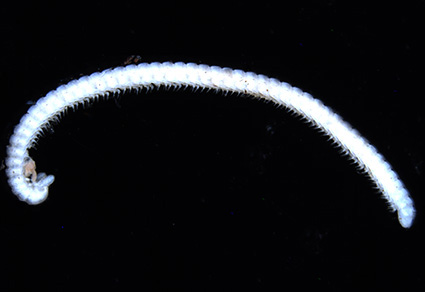Abstract
Millipedes of the family Siphonorhinidae Cook, 1895, famous for including the leggiest animal on this planet until recently, with up to 750 legs, show a disjunct distribution in California, South Africa and South-East Asia (from India to the Indonesian Islands of Java and Flores). Here I formally describe the first members of the family from Madagascar, Madagascarhinus madagascariensis n. gen., n. sp. and Madagascarhinus andasibensis n. gen., n. sp., from degraded central highland rainforests. Both species of Madagascarhinus n. gen. are relatively short (61 or 63 tergites), setose, pale and slender, and differ from the other known five genera of the family in numerous characters of the antennae, head, and tergites.
References
- Attems, C. (1938) Die von Dr. C. Dawydoff in französisch Indochina gesammelten Myriopoden. Mémoires du Muséum national d’histoire naturelle, NEW Series, 6, 187–353
- Blanke, A. & Wesener, T. (2014) Revival of forgotten characters and modern imaging techniques help to produce a robust phylogeny of the Diplopoda (Arthropoda, Myriapoda). Arthropod Structure and Development, 43, 63–75. https://doi.org/10.1016/j.asd.2013.10.003
- Brandt, J.F. (1837) Note sur un ordre nouveau de la classe des Myriapodes et sur l’etablissement des sections de cette classe d’animaux en général. Bulletin Scientifique publié par l‘Académie Impériale des Sciences de Saint-Pétersbourg, 1 (23), 178–179.
- Butler, A.G. (1872) Descriptions of new Myriopoda of the family Glomeridae. Annals and Magazine of Natural History, Series 4, 10, 354–359.
- Cook, O.F. (1895) Introductory note on the families of Diplopoda. In: Cook OF, Collins GN, The Craspedosomatidae of North America. Annals of New York Academy of Science, 9, 1–9. https://doi.org/10.1111/j.1749-6632.1896.tb55430.x
- Cook, O.F. & Loomis, H.F. (1928) Millipeds of the order Colobognatha, with descriptions of six new genera and type species, from Arizona and California. Proceedings of the United States National Museum, 72, 1–26. https://doi.org/10.5479/si.00963801.72-2714.1
- Enghoff, H., Golovatch, S., Short, M., Stoev, P. & Wesener, T. (2015) Diplopoda. In: Minelli, A. (Ed.), Treatise on zoology—anatomy, taxonomy, biology. The Myriapoda, 2 (16), pp. 363–453.
- Goodman, S.M., Rakotondravony, D., Schatz, G. & Wilmé, L. (1996) Species richness of forest-dwelling birds, rodents and insectivores in a planted forest of native trees: a test case from the Ankaratra, Madagascar. Ecotropica, 2, 109–120.
- Hilgert, M., Akkari, N., Rahmadi, C. & Wesener, T. (2019) The Myriapoda of Halimun-Salak National Park (Java, Indonesia): overview and faunal composition. Biodiversity Data Journal, 7, e32218. https://doi.org/10.3897/BDJ.7.e32218
- Hoffman, R.L. (1980) Classification of the Diplopoda. Muséum d’Histoire Naturelle. Geneve, pp. 1–237.
- Jeekel, C.A.W. (2001) A bibliographic catalogue of the Siphonophorida (Diplopoda). Myriapod Memoranda, 3, 44–71.
- Koch, C.L. (1847) System der Myriapoden. Pustet, Regensburg, 270 pp.
- Marek, P.E. & Bond, J.E. (2006) Rediscovery of the world’s leggiest animal. Nature, 441 (7094), 707.
- Marek, P.E., Shear, W.A. & Bond, J.E. (2012) A redescription of the leggiest animal, the millipede Illacme plenipes, with notes on its natural history and biogeography (Diplopoda, Siphonophorida, Siphonorhinidae). ZooKeys, 241, 77–112. https://doi.org/10.3897/zookeys.241.3831
- Marek, P.E., Krejca, J.K. & Shear, W.A. (2016) A new species of Illacme Cook & Loomis, 1928 from Sequoia National Park, California, with a world catalog of the Siphonorhinidae (Diplopoda, Siphonophorida). ZooKeys, 626, 1–43.
- Marek, P.E., Buzatto, B.A, Shear, W.A., Means, J.C., Black, D.G., Harvey, M.S. & Rodriguez, J. (2021) The first true millipede—1306 legs long. Scientific Reports, 11 (1). [published online] https://doi.org/10.1038/s41598-021-02447-0
- Moritz, L. & Parra-Gómez, A. (2023) XXX xxx sp. nov. gen. nov.: The first records of Siphonophorida in Chile and Siphonorhinidae in South America (Diplopoda, Colobognatha). Arthropod Systematics & Phylogeny. [in press]
- Moritz, L., Blanke, A, Hammel, J.U. & Wesener, T. (2021) First steps towards suctorial feeding in millipedes: Comparative morphology of the head of the Platydesmida (Diplopoda: Colobognatha). Invertebrate Biology, 2021, 00e12312. https://doi.org/10.1111/ivb.12312
- Moritz, L., Borisova, E., Hammel, J.U., Blanke, A. & Wesener, T. (2022) A previously unknown feeding mode in millipede and the convergence of fluid feeding across arthropods. Science Advances, 8 (7). [published online] https://doi.org/10.1126/sciadv.abm0577
- Pocock, R.I. (1894) Chilopoda, Symphyla and Diplopoda from the Malay Archipelago. In: Weber, M. (Ed.), Zoologische Ergebnisse einer Reise in Niederländisch Ost-Indien. Vol. 3. E.J. Brill, Leiden, pp. 307–404.
- Porat, C.O. (1872) Myripoda Africae australis, in Museo Regio Homiae asservata, recensuit. Öfversigt af Kongl. Vetenskaps-Akademiens Förhandlingar, 1872 (5), 3–46.
- Read, H.J. & Enghoff, H. (2009) The order Siphonophorida–A taxonomist’s nightmare? Lessons from a Brazilian collection. Soil Organisms, 81 (3), 543–543.
- Read, H.J. & Enghoff, H. (2018) Siphonophoridae from Brazilian Amazonia. Part 1. The genus Columbianum Verhoeff, 1941 (Diplopoda, Siphonophorida). European Journal of Taxonomy, 477, 1–23.
- Read, H.J. & Enghoff, H. (2019) Siphonophoridae from Brazilian Amazonia. Part 2. Two new tree-climbing species of the genus Siphonophora, including one showing pilosity polymorphism (Diplopoda, Siphonophorida). European Journal of Taxonomy, 496, 1–26. https://doi.org/10.5852/ejt.2019.496
- Shelley, R.M. & Hoffman, R.L. (2004) A contribution on the South African millipede genus, Nematozonium Verhoeff, 1939 (Siphonophorida: Siphonorhinidae). African Entomology, 12 (2), 217–222.
- Spelzhausen, L., Wesener, T. & Schütte, K. (2020) Vegetation thresholds for the occurrence of millipedes (Diplopoda) in different tropical forest types in Andasibe, Madagascar. Madagascar Conservation and Development, 15 (1), 1–8. https://doi.org/10.4314/mcd.v15i1.3
- Verhoeff, K.W. (1939) Polydesmoideen, Colobognathen und Geophilomorphen aus Südafrica, besonders den Drakensbergen, Natal. Annals of the Natal Museum, 9, 203–224.
- Wesener, T. (2014) First records of the order Siphonophorida from Madagascar and Mauritius (Diplopoda). Revue Suisse de Zoologie, 121 (3), 415–423.
- Wesener, T. & Anilkumar, P.A. (2020) The millipedes collected by the Museum “La Specola” on Madagascar 1989/1991, with the description of three new species of giant pill-millipedes (Diplopoda, Sphaerotheriida, Arthrosphaeridae). In: Korsós, Z. & Dányi, L. (Eds.), Proceedings of the 18th International Congress of Myriapodology, Budapest, Hungary. ZooKeys, 930, pp. 3–35. https://doi.org/10.3897/zookeys.930.47620
- Wesener, T. & Moritz, L. (2018) Checklist of the Myriapoda in Cretaceous Burmese amber and a correction of the Myriapoda identified in Zhang (2017). Check List, 14 (6), 1131–1140. https://doi.org/10.15560/14.6.1131
- Wesener, T., Enghoff, H. & Sierwald, P. (2009) Review of the Spirobolida on Madagascar, with descriptions of twelve new genera, including three genera of ‘Fire Millipedes’ (Diplopoda). ZooKeys, 19, 1–128.


